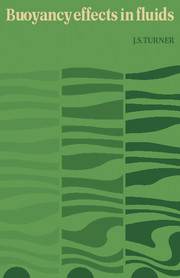Book contents
- Frontmatter
- Contents
- Preface
- 1 INTRODUCTION AND PRELIMINARIES
- 2 LINEAR INTERNAL WAVES
- 3 FINITE AMPLITUDE MOTIONS IN STABLY STRATIFIED FLUIDS
- 4 INSTABILITY AND THE PRODUCTION OF TURBULENCE
- 5 TURBULENT SHEAR FLOWS IN A STRATIFIED FLUID
- 6 BUOYANT CONVECTION FROM ISOLATED SOURCES
- 7 CONVECTION FROM HEATED SURFACES
- 8 DOUBLE-DIFFUSIVE CONVECTION
- 9 MIXING ACROSS DENSITY INTERFACES
- 10 INTERNAL MIXING PROCESSES
- Bibliography and Author Index
- Recent Publications
- Subject Index
- Plate section
9 - MIXING ACROSS DENSITY INTERFACES
Published online by Cambridge University Press: 05 August 2012
- Frontmatter
- Contents
- Preface
- 1 INTRODUCTION AND PRELIMINARIES
- 2 LINEAR INTERNAL WAVES
- 3 FINITE AMPLITUDE MOTIONS IN STABLY STRATIFIED FLUIDS
- 4 INSTABILITY AND THE PRODUCTION OF TURBULENCE
- 5 TURBULENT SHEAR FLOWS IN A STRATIFIED FLUID
- 6 BUOYANT CONVECTION FROM ISOLATED SOURCES
- 7 CONVECTION FROM HEATED SURFACES
- 8 DOUBLE-DIFFUSIVE CONVECTION
- 9 MIXING ACROSS DENSITY INTERFACES
- 10 INTERNAL MIXING PROCESSES
- Bibliography and Author Index
- Recent Publications
- Subject Index
- Plate section
Summary
In this chapter we will consider the processes of formation of mixed layers by externally driven turbulence, and entrainment of fluid across the interfaces bounding such layers. Mixing across a density interface has so far been treated only in the special context of double-diffusive convection (§8.3), but more general stirring mechanisms must now be discussed. The problems of interest here may be identified with cases (d) or (e) of fig. 4.19, in which stirring at one level is used to produce mixing across an interface located some distance below or above the source of turbulent energy.
Various laboratory experiments which have shed light on the mechanism of entrainment at a density interface will be described first. Mixing can be generated by mechanical stirring, or by the production of a mean turbulent flow in the surface layer, and both methods have been used. The observed structure of the surface layers of the ocean and atmosphere discussed in §10.1 suggest that mixing in those regions is dominated by the boundary processes. The laboratory results can immediately be applied to these geophysical examples, and, with the addition of results from the earlier chapters on convection, they can be extended to take account of convective as well as mechanical mixing. It is assumed throughout this chapter that the mixing processes under consideration can be treated as one-dimensional in depth, implying that mixing is uniform (in the mean) over a large horizontal area, with no significant contribution from large scale lateral convection.
- Type
- Chapter
- Information
- Buoyancy Effects in Fluids , pp. 288 - 312Publisher: Cambridge University PressPrint publication year: 1973
- 4
- Cited by

